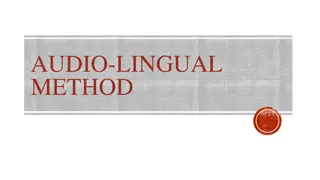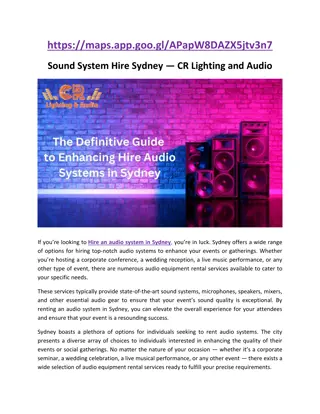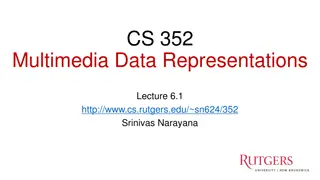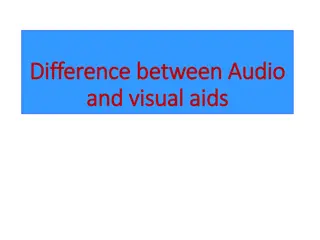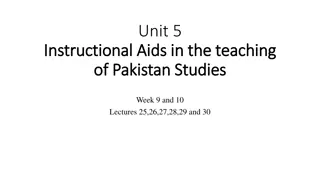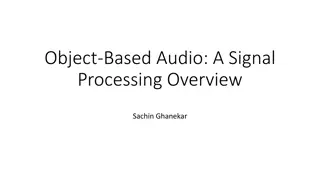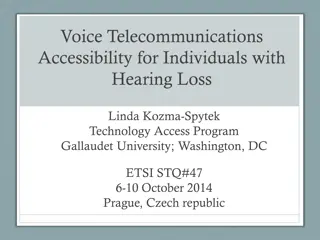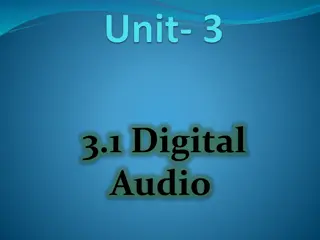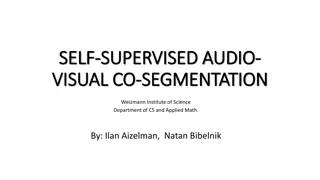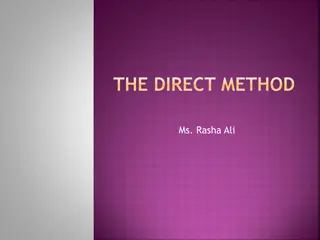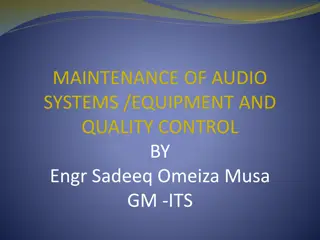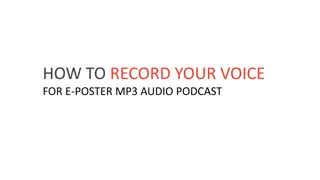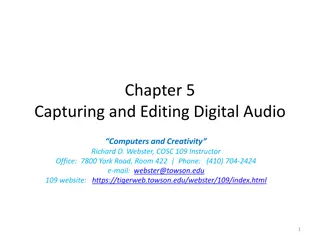Exploring the Audio-Lingual Method in Language Teaching
The Audio-Lingual Method is an oral-based approach that focuses on drilling students in grammatical sentence patterns through behavioral psychology principles. This method, also known as the Michigan Method, emphasizes habit formation and uses techniques like dialogues, repetition drills, and role-play to foster language acquisition. Teachers play a crucial role in providing models for imitation, while students learn through imitation, repetition, and positive reinforcement. The goal is for students to use the target language communicatively and form new language habits.
Download Presentation

Please find below an Image/Link to download the presentation.
The content on the website is provided AS IS for your information and personal use only. It may not be sold, licensed, or shared on other websites without obtaining consent from the author. Download presentation by click this link. If you encounter any issues during the download, it is possible that the publisher has removed the file from their server.
E N D
Presentation Transcript
The Audio-Lingual Method Ms.RashaAli
Introduction Introduction Audio-Lingual Method is an oral-based approach. - It drills students in the use of grammatical sentence patterns. -Based on behavioral psychology (Skinner). - Conditioning helping learners to respond correctly to stimuli through shaping and reinforcement. - -Habit-formation -It is referred to as the Michigan Method -Charles Fries (1945) applying principles from structural linguistics in developing the method. - - - -
Give it a try, Give it a try, page page 36 36 - - 42 42 -Sally : Good morning, Bill. -Bill: Good morning, Sally. -Sally: How are you? -Bill: Fine, Thanks, And you? -Sally: Fine. Where are you going? -Bill: I m going to the post office. -Sally: I am too. Shall we go together? -Sure. Let s go
I I m going to the post office m going to the post office 1. introduces a new dialog (p36) 2. uses a backward build-up drill 3. uses a repetition drill (group) 4. initiates a chain drill (individual) 5. leads a single-slot substitution drill (replaces a word or phrase = cue) (shows pictures) 6. praise the class during the practice
How are you? How are you? S V agreement 1. subject pronouns (he, she, they, you) 2. be verb (is, are) 3. uses Multiple-slot Substitution drill (I am/ She is going to the post office) 4. uses a transformation drill (active vs. passive; yes/no- question) 5. uses pictures again and select individuals
Method principles Method principles 1.Teacher goal: -Teachers want their students to be able to use the target language communicatively. -Over learning automatically without stopping to think -Forming new habits through overcoming the old habit.
2. Teacher Role/Student Role - The teacher is like an orchestra leader. - Providing students with a good model for imitation. - Students are imitators.
3. Characteristics of the teaching/learning process - New vocabulary and structural patterns are presented through dialogs. - Dialogs learning through imitation and repetition - Positively reinforced - Grammar is induced from the examples.
4 4. . Student-teacher interaction/ student-student interaction Interaction is teacher-direct. - - Student-student interaction Chain drills and dialogues
5 5. . The view of language/ the view of culture - The view of language be influenced by descriptive linguists. - Each level( phonological, morphological )has its own distinctive patterns. - Everyday speech is emphasized. - The level of complexity of the speech is graded.
6.What areas of language are emphasized? What language skills are emphasized? Vocabulary is kept to a minimum while the students are mastering the sound system and grammatical patterns. - The natural order of skills presentation is adhered to : listening, speaking, reading, and writing. - - The oral/aural skills receive most of the attention .
7. The role of native language The habits of the students native language are thought to interfere with the students attempts to master the target language. - - The target language is mostly used in the classroom instead of the native language.
8. Evaluation - Nature: discrete-point each question on the test would focus on only one point of the language at a time. Ex: students might be asked to distinguish between words in a minimal pair.
9. Deal with errors Students errors are to be avoided if at all possible through the teacher s awareness of where the students will have difficulty and restriction of what they are taught to say.
Method Method s Techniques s Techniques 1. Dialog memorization 2. Backward build up drill 3. Repetition drill 4. Chain drill 5. Single slot substitution drill 6. Multiple slot substitution drill 7. Transformation drill 8. Question and answer drill 9. Use of minimal pairs 10. Complete the dialog 11. Grammar game
Brainstorming Page 50 - Check your understanding of The Audio-Lingual Method




